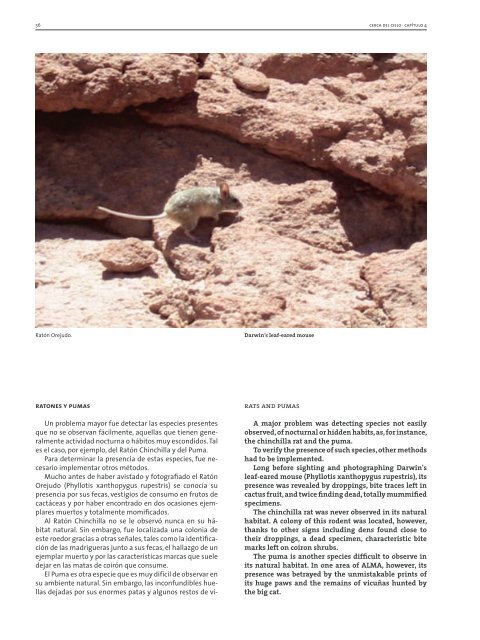You also want an ePaper? Increase the reach of your titles
YUMPU automatically turns print PDFs into web optimized ePapers that Google loves.
56 <strong>cerca</strong> <strong>del</strong> <strong>cielo</strong> M capítulo 4<br />
Ratón Orejudo. Darwin’s leaf-eared mouse<br />
ratones y pumas<br />
Un problema mayor fue detectar las especies presentes<br />
que no se observan fácilmente, aquellas que tienen generalmente<br />
actividad nocturna o hábitos muy escondidos. Tal<br />
es el caso, por ejemplo, <strong>del</strong> Ratón Chinchilla y <strong>del</strong> Puma.<br />
Para determinar la presencia de estas especies, fue necesario<br />
implementar otros métodos.<br />
Mucho antes de haber avistado y fotografiado el Ratón<br />
Orejudo (Phyllotis xanthopygus rupestris) se conocía su<br />
presencia por sus fecas, vestigios de consumo en frutos de<br />
cactáceas y por haber encontrado en dos ocasiones ejemplares<br />
muertos y totalmente momificados.<br />
Al Ratón Chinchilla no se le observó nunca en su hábitat<br />
natural. Sin embargo, fue localizada una colonia de<br />
este roedor gracias a otras señales, tales como la identificación<br />
de las madrigueras junto a sus fecas, el hallazgo de un<br />
ejemplar muerto y por las características marcas que suele<br />
dejar en las matas de coirón que consume.<br />
El Puma es otra especie que es muy difícil de observar en<br />
su ambiente natural. Sin embargo, las inconfundibles huellas<br />
dejadas por sus enormes patas y algunos restos de vi-<br />
rats and pumas<br />
A major problem was detecting species not easily<br />
observed, of nocturnal or hidden habits, as, for instance,<br />
the chinchilla rat and the puma.<br />
To verify the presence of such species, other methods<br />
had to be implemented.<br />
Long before sighting and photographing Darwin's<br />
leaf-eared mouse (Phyllotis xanthopygus rupestris), its<br />
presence was revealed by droppings, bite traces left in<br />
cactus fruit, and twice finding dead, totally mummified<br />
specimens.<br />
The chinchilla rat was never observed in its natural<br />
habitat. A colony of this rodent was located, however,<br />
thanks to other signs including dens found close to<br />
their droppings, a dead specimen, characteristic bite<br />
marks left on coiron shrubs.<br />
The puma is another species difficult to observe in<br />
its natural habitat. In one area of ALMA, however, its<br />
presence was betrayed by the unmistakable prints of<br />
its huge paws and the remains of vicuñas hunted by<br />
the big cat.

















